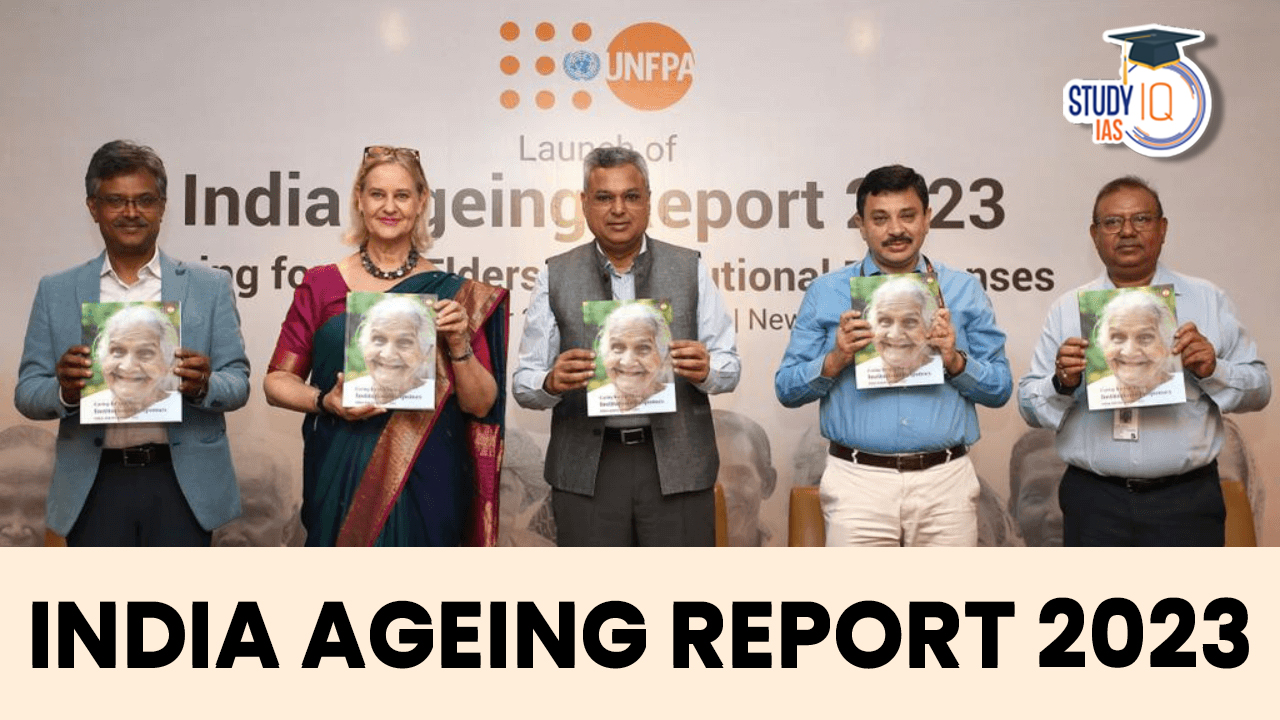Context: UNFPA (United Nations Population Fund) India, in collaboration with the International Institute for Population Sciences (IIPS), has released the “India Ageing Report 2023.”
Major Findings of the Report
1) Status of the Older Population in India
a) Ageing in India: Levels and Trends:
| Prospects of the older population |
- The share of population over the age of 60 years is projected to increase from 10.5 percent in 2022 to 15 percent in 2036, and 20.8 percent in 2050.
- By the end of the century, the elderly will constitute over 36 percent of the total population of the country.
|
| Regional disparities |
- States in the southern region and select northern states like Himachal Pradesh and Punjab report a higher share of the elderly population than the national average.
- In contrast, states with higher fertility rates and slower demographic transitions like Bihar and Uttar Pradesh will see an increase in the share of the elderly population but at a lower level than the national average.
|
| Ageing index |
- The ageing index measures the number of elderly (60+ years) per 100 children population (below 15 years) and the index score increases as the population ages.
- There are 39 older persons per 100 children in India according to 2021 population estimates.
- Compared to southern and western India, central and north–eastern regions have the younger group of states as indicated by the ageing index.
|
| Old-age dependency ratio |
- The old-age dependency ratio of a population represents the number of persons aged 60+ years per 100 persons in the 15–59 years (or working-age) group.
- The higher the ratio, the greater the old age-related dependency, reflecting higher levels of demand for care from immediate family.
- There were 16 older persons per 100 working-age persons in India in 2021.
- In the southern region, the old-age dependency ratio was higher than the national average at around 20.
|
| Life expectancy |
- At 60 years, a person in India may expect to live another 18.3 years, which is higher in case of females at 19 years as compared to males at 17.5 years.
|
b) Challenging Trends of Ageing Population in India:
- Feminization: Women, on average, have a higher life expectancy at the ages of 60 and 80 compared to men.
- Ruralization: According to Census of India 2011, on an average, 71 percent of older persons live in rural areas.
- Ageing of the aged: During 2000–2022, the total population of the country grew by 34 percent, while the population of 60+ years grew by 103 percent, whereas 80+ years grew by 128 percent during the same period.
c) Vulnerability among Older Population:
- Health related vulnerability: In India, nearly one-fifth of the elderly have at least one Activities of Daily Living (ADL) limitation. And, overall prevalence of multi-morbidity in elderly is 23.3 percent in India.
- Economic vulnerability: Overall, more than two-fifth of the elderly in India are in the poorest wealth quintile.
2) Response from Government
| Social Security and Welfare Schemes |
- Antodaya Anna Yojana: highly subsidized food grains to poorest families including elderly.
- Pradhan Mantri Vaya Vandana Yojana: insurance scheme for senior citizens that offers guaranteed pension income.
- Varishtha Pension Bima Yojana: pension scheme for elderly citizens, providing regular income and financial security.
- Indira Gandhi National Old Age Pension Scheme (IGNOAPS): social security program that provides financial assistance to elderly individuals in need.
- Jeevan Pramaan: A digital life certificate for pensioners, simplifying the pension verification process.
- Atal Pension Yojana: aimed at providing a stable income to individuals during their retirement years.
- Pradhan Mantri Suraksha Bima Yojana: insurance scheme that offers accidental death and disability coverage to citizens.
- Senior Citizens’ Savings Scheme (SCSS): A savings scheme designed for senior citizens, offering regular interest income.
|
| Legislations Related to Older Persons |
- Maintenance and Welfare of Senior Citizens Act, 2007
- National Policy on Older Persons, 1999
- National Council of Senior Citizens
- Senior Citizens’ Welfare Fund
|
| Programmes for the Elderly |
- Atal Vayo Abhyuday Yojana
- Rashtriya Vayoshri Yojana
- Anubhav platform
|
3) Recommendations by the Report
- Strengthening the National Policy on Older Persons (NPOP) and enhancing collaboration among various ministries for its effective implementation.
- Encouraging regular feedback and audits of programs for senior citizens to improve their relevance and impact.
- Mobilizing funds, including corporate social responsibility (CSR) funds, to support the development of Community-Based Organizations (CBOs) serving the elderly.
- Promoting intergenerational solidarity to nurture relationships between generations and highlight the contributions of the elderly.
- Strengthening Panchayati Raj Institutions (PRIs) and expanding their capacity to support senior citizens at the community level.
- Encouraging private sector participation in elder care and establishing public-private collaborations to address issues related to aging.
- Focusing on older persons’ needs in disaster preparedness plans and creating a network of helplines for their support.
- Enhancing data systems and conducting micro-level studies to better understand the elderly population and improve programs and initiatives for their well-being.
Sharing is caring!


 Daily Quiz 11 July 2025
Daily Quiz 11 July 2025
 Operation Baam: Baloch Separatist Group ...
Operation Baam: Baloch Separatist Group ...
 Article 326 and Electoral Roll Revision ...
Article 326 and Electoral Roll Revision ...





















